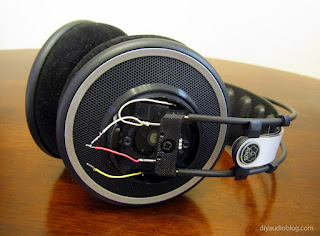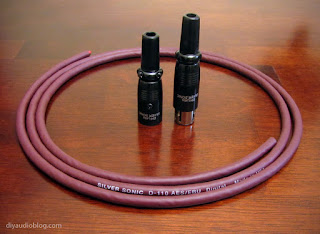It's been a little while since the last post, and there's a good reason for that; I've been gathering parts for a very special DIYTube Get Set Go made specifically for the Audeze LCD-2 headphones. The Get Set Go is a single-ended triode design made first-and-foremost for high-sensitivity speakers that only need a few watts to fill a room with sound, such as the
Planet 10 Audio Frugel Horn. I did have the fortune to build the Get Set Go for speakers
previously and was impressed with the overall tonal character and quality of the sound.
![]() |
| The Get Set Go Board from DIYTube |
You may be wondering why someone would be using a speaker amp for a pair of headphones. A typical headphone amplifier will output relatively a small amount of power compared to the speaker amplifiers (in small fractions of a watt measured in milliwatts). The Audeze, as well as certain other planar magnetic headphones like the HiFiMan, really benefit from some added wattage to sound their best as they aren't the most sensitive drivers. Hense, using a low-powered speaker amplifier makes sense, but there are some changes that are necessary.
The biggest change is the output impedance. While speakers are typically 4, 8 or 16 ohm, headphones often range between 32 and 600 ohm. The Audeze headphones that the amplifier is being made for are 50 ohm (although I have also seen them listed as 60 ohm). Since 50 ohm single-ended output transformers don't really exist on the market, you can either have one custom wound, or try and find something that would have an equivalent turn ratio. There's a handy
calculator that Shannon of DIYTube recommended that will give the equivalent turn ratio for this purpose. A 3.5K / 50 ohm output transformer would have a turns ratio of 0.12, or 8.367:1. Gery at Transcendar offers a 1.6K / 16 ohm single-ended transformer, the TT-023-OT, which is a 10:1 ratio and close enough for our purposes. Per Shannon, The reflected load would be a touch more linear and lost max output would be minimal.
Secondly, learned from previous experiences like with the
Millet Jonokuchi, and to a much lesser extent, the
ECP Audio Torpedo, headphone amplifiers do not like their output transformers to be close to the power transformer. When they are too close in proximity, there is something called flux interaction when the magnetic waves interfere with one-another and cause an audible hum with certain headphones. So not only will the output transformers be moved to the opposite side of the chassis, but rather than using an EI transformer for power, a toroid will be used instead as they create much less of a magnetic field. Antec is one of the few manufacturers out there that builds certain toroids specifically for tube amplifiers. The Antec AS-2T300 would be a good substitute for the PA774 with a bit higher ratings.
So other than the transformer choices and their position, this build will be fairly similar to the previous Get Set Go. To make things a little different, 300B tubes will be used rather than 6B4Gs. Also Mundorf Silver Oil capacitors will be taking the place of the Jupiter wax paper caps. The Mundorfs should be a little more detailed, which the Audeze can benefit from with their warmer/darker presentation.
The first action-item on the list was the chassis. I always like to create a virtual mock-up of the chassis layout to see different set-ups and settle on what I feel will work the best. Note that in this layout, the output transformers are distanced from the power toroid and chokes.
![]() |
| Virtual Chassis Layout |
Once this is settled, I forwarded the dimensions over to Keith (ebay seller po1019) to fabricate the chassis. The virtual layout is then used as a guide to lay out the parts, take measurements and make markings, and ultimately start drilling / cutting away. After prepping a number of aluminum and steel chassis, I have a small collection of very handy Greenlee punches, which are ideal for making clean holes for tubes and sockets. The metal area (which will be behind the little red tab on the Neutrik locking plug) to release the headphone plug was recessed a bit by sanding using a Dremel and by hand for adequate clearance.
![]() |
| The prepped aluminum chassis |
I decided that this chassis would have a more unique and artistic finish. Something more worn and rustic looking. I was actually inspired when I was scrapping off the dark grease on an old baking sheet. This finish starts with some black engine enamel that is then sanded and scrapped by hand minutes after spraying. It produces and interesting texture in my humble opinion.
![]() |
| Textured Bottom Plate |
![]() |
| Texture Detail |
The texture is achieved by hand using worn out sandpaper at different times of paint dryness, along with the sharp point of a scissor to get the longer lines. Once the texture was where I wanted it, I gave the chassis two coats of clear satin enamel. The parts can now be dropped in place. I began with the smaller pieces, including the headphone sockets, which were flush mounted and secured with black oxide screws. The switch, pilot light, RCAs, binding posts, IEC, Teflon 300B sockets and hole grommets were all installed next.
![]() |
| Part installation on the chassis |
Next comes the fun part, the population of the PCB. Varying from the BoM, we have Elma Silmic II caps, Nichicon FineGold caps, Kiwame and Mills resistors and Mundorf Silver/Oil Caps. Slight changes to the circuit includes the Wima 0.1uF snubber cap and a pair of Solen 630V 5.6uF bypass caps in the power section.
![]() |
| The populated Get Set Go Board |
On the bottom of the board, at Shannon's suggestion, we have a few of the Mills power resistors to help distribute the heat a little better.
![]() |
| Bottom of the board |
Now comes the long process of preparing the wood side panels. I decided on an antique silver leaf finish for these pieces. Since there is no off-the-shelf option for antique silver leaf that was readily available, I'm using some Speedball brand silver leaf pieces and some Old World Art brand leafing and antiquing materials.
![]() |
| Leafing Materials |
Below are the wood side panels for the chassis before any prep.
![]() |
| Wood Chassis Panels |
The first step in the antique leafing process is a red basecoat. This is typically used with a gold foil, so we'll see how it performs with silver. Below is the wood with the basecoat applied.
![]() |
| Red antique basecoat |
After two basecoats and a layer of adhesive size, the wood is covered with the silver foil sheets. This is a very unusual process, the foil is incredibly thin and will tear apart if it catches your fingers, so you have to be delicate. each foil sheet is laid down with a little bit of overlap.
![]() |
| Silver foil sheets laid in place |
The foil is then burnished with a cheesecloth to have it form the curves of the wood. This is a messy process and the foil flakes will end up everywhere. They are so thin that you'll find them floating in the air. Once this is complete, a layer of sealant is used to protect the foil.
![]() |
| Silver foil after burnishing |
The antiquing kit included an antique glaze that is made for gold so it's a brownish hue. It didn't look right on the silver. Instead I chose to rub it down with powdered graphite before sealing it again. Then two layers of satin clearcoat were added for additional protection of the finish.
More to comePlease remember that building circuits and performing circuit modifications can be dangerous to you and/or your surroundings and should only be performed by a certified technician. The owner of this blog and all associated parties can not / will not be held responsible if you attempt a build or modification posted above and cause physical harm to yourself or your surroundings. Many electronics contain high voltages that can kill, and mods, if performed improperly, can be a fire hazard. Please keep this in mind.














































































































































































































